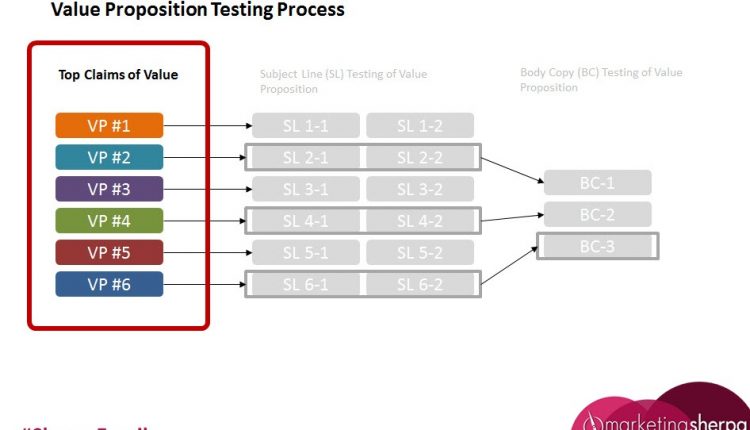Value Proposition Optimization: 5 simple steps to discovering your value proposition using an email campaign
“So, why should I purchase from you rather than any of your competitors?” your ideal customer hypothetically asks you …
“Well, because …” you begin, “[insert your value proposition here].”
Until you can give your customers a convincing answer to that question, your company is simply surviving on pockets of ignorance. So, marketer, what’s the best way to answer that question?
The truth is, you can come up with preliminary answers using your intuition, but you’ll never know the best answer until you test …
And one of the most effective test-beds for getting the absolute best answer to the question is an email campaign.
At MarketingSherpa Email Summit 2013, presenter Austin McCraw, Senior Editorial Analyst, MECLABS, shared how an email can become much more than a one-off marketing message.
In his session titled, “How You Can Use Email to Discover the Essence of Your Value Proposition,” Austin explained how marketers can use email campaigns to understand the core motivations of their customers.
Austin provided a several key reasons for why email campaigns make a great proving ground for testing value proposition, including:
- Ease of change
- Large sample sizes
- Highly competitive environment
And my favorite … it’s something you have to do already.
“Testing value propositions in your email sends is one of the easiest ways to create a culture of testing within your organization,” Austin said.
So today’s MarketingExperiments blog post will share Austin’s five steps for using your email marketing campaigns to discover your value proposition. Our goal is to provide a systematic approach you can use to aid your value proposition development and testing efforts.
Step #1: Identify potential claims of value
Identifying potential claims of value is really all about brainstorming. The example Austin gave for this was to imagine you are selling mortgages. What would be potential claims of value you could make?
Austin came up with some potential claims of value for selling mortgages:
- Reliability
- Lowest rates
- Easy process
- Brand name
- Payment plan options
- Reduced anxiety
- Service quality
- Community involvement
Step #2: Estimate the force of each claim
 You can estimate the force of your claims by using elements of appeal and exclusivity to rank the potential claims you brainstormed for your product.
You can estimate the force of your claims by using elements of appeal and exclusivity to rank the potential claims you brainstormed for your product.
Austin explained how the elements are perceived by potential prospects.
Appeal – “I want this”
Exclusivity – “I can’t get this anywhere else”
Some of your offers will have a greater appeal, but they may not be very exclusive. Other offers might be exclusive, but offer little appeal to your customers.
“You want to test claims that have high levels of both appeal and exclusivity,” Austin explained.
Step #3: Test within subject lines (Round 1)
 Next, Austin showed the audience how ranked value proposition claims should be crafted into competing subject lines and tested using multivariate A/B testing.
Next, Austin showed the audience how ranked value proposition claims should be crafted into competing subject lines and tested using multivariate A/B testing.
Using subject lines in split tests gives marketers a quick way to begin discovering which of your value propositions have greater appeal with your customers. This is also where those large sample sizes come in handy for validating your test results.
“This initial round of testing is where you can eliminate some of the less appealing and exclusive claims,” Austin declared.
Step #4: Test within body copy (Round 2)
Once you have isolated a few of the more appealing value propositions through testing, you can begin to further test the winning claims by infusing them into the body copy of your emails.
Some of the most optimal places Austin suggested for infusing value proposition claims into your emails are:
- First sentence
- Featured bullets
- Bold phrases
- Call-to-action
- Post-script
Step #5: Interpret and implement
 Austin ended the session by explaining the importance interpretation and implmenetaion play in the analysis of metrics from your tests.
Austin ended the session by explaining the importance interpretation and implmenetaion play in the analysis of metrics from your tests.
He emphasized three critical questions your test interpretations should answer:
- What was the financial impact of the test?
- What did we learn about our customer?
- Where can we apply these insights?
Related Resources:
Email Marketing: What you can learn from an 80% decrease in clickthrough rate
Discovering Your Value Proposition: 6 ways to stand out in a crowded marketplace (Web clinic replay)






Thanks for the very in-depth view of email marketing. I understood most of it. I would like to have seen the pictures more clearly and didn’t realize until I was half way down that I could click on them to see the large image. Thanks again. I am adding your blog to my RSS reader.
I would like to know the size of the email list and how many were emailed in each test and the differences in Open Rate and CTR.